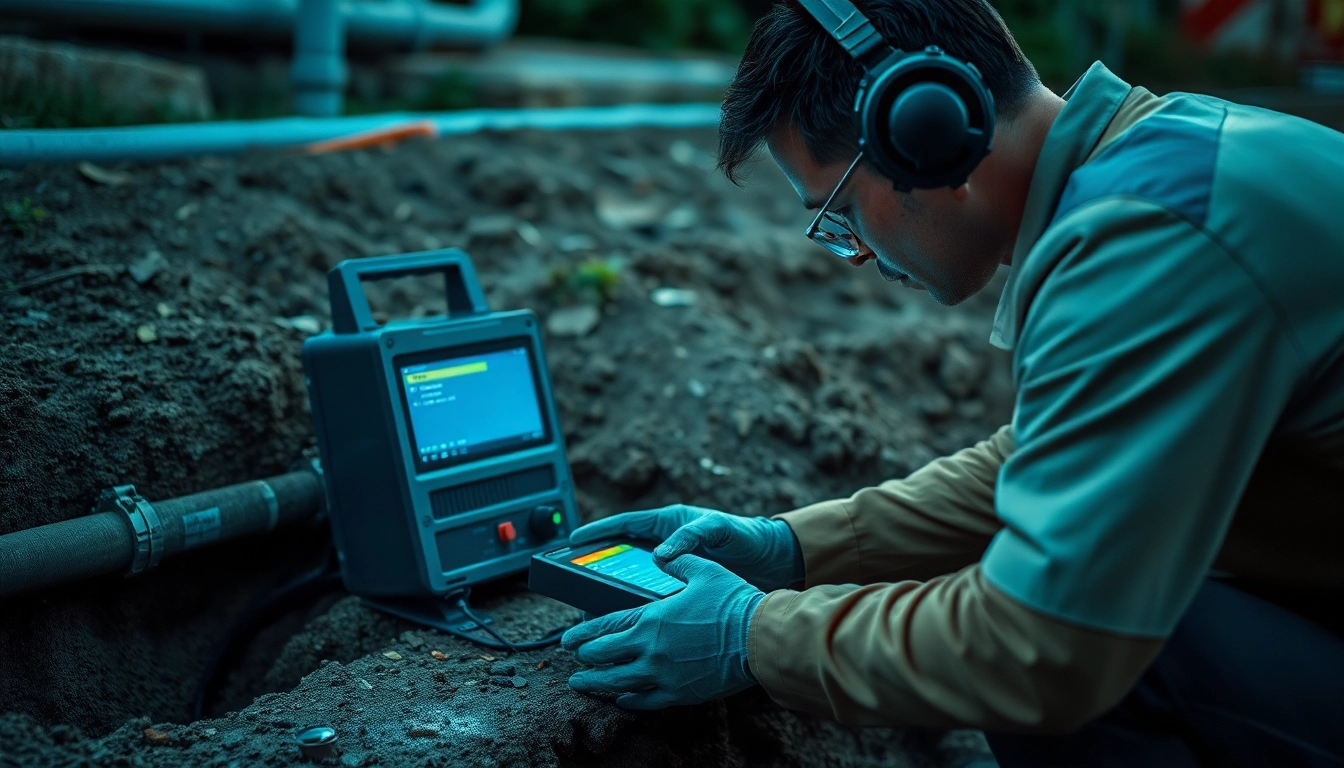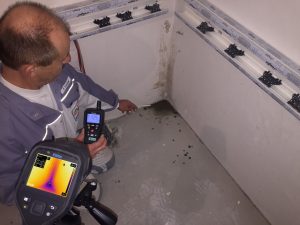Ultimate Guide to Underground Leak Detection: Essential Strategies

Understanding Underground Leak Detection Techniques
In an age where water conservation and infrastructure integrity are paramount, Underground Leak Detection has emerged as a critical service for both homes and businesses. Leaks, whether in residential pipes or extensive commercial systems, can lead to water loss, structural damage, and increased utility bills. This article delves deep into the mechanisms, methodologies, and significance of effective leak detection.
Overview of Common Detection Methods
Detecting underground leaks involves a variety of sophisticated methods. Each technique has its own strengths and is suited for specific situations. The most common techniques include:
- Acoustic Leak Detection: This method utilizes sound waves to locate leaks. Professional leak detectors often use sensitive microphones to identify the distinct sounds of water escaping pipes.
- Infrared Thermography: Thermal imaging cameras can identify temperature differences in the ground, highlighting areas where water might be pooling due to a leak.
- Ground Penetrating Radar (GPR): GPR systems use radar pulses to image the subsurface and accurately locate pipes and leaks, making it a reliable option for complex infrastructure.
- Tracer Gas Detection: This method introduces a harmless gas, such as helium or hydrogen, into the plumbing system. The escaping gas is detected at the surface, helping pinpoint leaks.
Identifying Types of Underground Leaks
Understanding the types of leaks is crucial for determining the appropriate detection method. Common types of underground leaks include:
- Minor Leaks: These leaks often go unnoticed and can progressively lead to significant water loss.
- Major Leaks: Characterized by visible signs such as water pooling or soil erosion, these leaks often require immediate attention.
- Service Line Leaks: Occurring in service connections from mains to properties, they may affect water quality and pressure.
- Environmental Leaks: These can occur in sewer lines, leading to potential contamination of soil and groundwater.
Importance of Early Detection
Early detection is vital for minimizing the impact of leaks. Procrastination can lead to:
- Increased water bills due to excessive usage.
- Damage to property, including mold growth and structural issues.
- Environmental consequences, such as contamination and harm to local ecosystems.
Investing in underground leak detection not only preserves water but also safeguards your property’s integrity and value.
Professional vs. DIY Underground Leak Detection
When faced with the challenge of detecting underground leaks, property owners often weigh the option of hiring professionals against attempting the task themselves. Each option carries its own merits and drawbacks.
Pros and Cons of Professional Services
Professional leak detection services typically offer comprehensive assessments using advanced technology, enabling them to accurately locate leaks. Advantages and disadvantages of hiring professionals include:
- Pros:
- Access to specialized equipment and expertise increases the likelihood of accurate detection.
- Professionals can address and rectify the issue swiftly, preventing further damage.
- Cons:
- Cost can be a deterrent for some homeowners, with fees varying significantly.
- There may be delays in scheduling unless in emergencies.
Effective DIY Techniques for Homeowners
Homeowners who prefer a hands-on approach can utilize several DIY techniques for initial leak detection:
- Visual Inspection: Regularly checking for signs of water pooling, damp spots, and unusually lush vegetation can provide clues.
- Listening for Sounds: In quiet moments, listening for hissing or rushing water sounds might reveal a leak’s location.
- Pressure Testing: Reducing water pressure temporarily can help identify issues, as pressure fluctuations could indicate leaks.
Though these methods may not be foolproof, they serve as a valuable first step before engaging professionals.
When to Call a Professional
Knowing when to involve professionals is crucial. Here are instances when it’s essential:
- Unexplained spikes in water bills that can’t be accounted for through increased usage.
- Visible signs of water damage, including mold growth and pooling water.
- When DIY methods have been exhausted without success.
In these scenarios, professional intervention not only ensures accurate detection but also effective resolution.
Tools and Equipment for Effective Underground Leak Detection
The right tools can make all the difference when it comes to detecting underground leaks. Both professionals and DIY enthusiasts can benefit from the following equipment.
Essential Tools for Professionals
Professionals typically rely on specialized equipment including:
- Acoustic Listening Devices: These devices can isolate the sound of leaks from background noise.
- Thermal Imaging Cameras: These help visualize heat patterns, indicating potential leak areas based on temperature discrepancies.
- Ground Penetrating Radar: GPR systems enable non-invasive imaging of underground structures, allowing accurate leak detection without extensive digging.
Using these tools allows professionals to pinpoint leaks efficiently, significantly reducing the time and resources needed for repairs.
Recommended Equipment for DIY Enthusiasts
For those looking to perform basic leak detection themselves, several tools can aid in the process:
- Water Leak Detection Sensors: Simple devices that can alert homeowners to moisture levels rising in undesirable locations.
- Digital Pressure Gauges: This equipment allows individuals to monitor water pressure, helping identify issues if pressure suddenly drops.
- Basic Acoustic Devices: More affordable than professional-grade devices, they can still allow users to hear the sounds of water escaping.
Though the precision may not match professional use, these tools can provide a significant advantage in identifying potential issues early.
Innovations in Leak Detection Technology
As technology evolves, so does the precision and effectiveness of leak detection. Key innovations include:
- AI Integration: Some systems now use AI to analyze data from various sensors, allowing for faster and more accurate leak location.
- Smart Water Meters: These devices monitor usage in real-time, alerting homeowners to irregularities that could suggest leaks.
- Mobile Applications: New apps provide real-time insights into water usage and potential leaks, enhancing consumer knowledge and responsiveness.
By embracing these innovations, property owners can enhance their leak detection strategy, maximizing efficiency and minimizing costs.
Exploring the Costs of Underground Leak Detection Services
Understanding the financial implications of underground leak detection helps homeowners make informed decisions. Costs can fluctuate based on several factors.
Factors Affecting Cost
Several elements influence the overall price of leak detection services:
- Complexity of the Inspection: More complicated systems generally incur higher costs.
- Type of Equipment Used: Advanced technology often requires a premium.
- Location and Accessibility: Hard-to-reach areas may demand more labor, increasing expenses.
Price Range for Various Services
While prices can vary widely, a rough estimate for underground leak detection services can be outlined as follows:
- Basic inspections may range from $200 to $500.
- Extended services involving complex technology could cost $500 to $1,500.
- Emergency services tend to carry a premium, often exceeding standard rates.
Given the potential savings from promptly addressing leaks, investing in professional detection can be economically beneficial in the long run.
Budgeting for Leak Detection Solutions
When planning for potential leak detection services, consider the following strategies:
- Annual Inspections: Schedule routine inspections as a preventive measure to catch leaks early.
- Set Aside a Contingency Fund: Allocate budget resources specifically for plumbing issues to avoid financial strain when leaks are discovered.
Being proactive about leak detection not only conserves resources but also enhances home safety and structural integrity.
Case Studies: Successful Underground Leak Detection
Real-world examples illustrate the impact of effective underground leak detection. By studying these cases, homeowners can better understand the importance and effectiveness of various techniques.
Notable Examples of Leak Resolutions
Case studies often reveal successful interventions where timely leak detection mitigated damage:
- One residential case involved a family which noticed increased water bills. A professional inspection revealed a leak in the service line, which was repaired promptly, saving significant costs in further damages.
- In a commercial property, thermal imaging detected hidden leaks in the foundation before they led to structural failure, showcasing the effectiveness of advanced technologies in preventing costly emergency repairs.
Learning from Field Challenges
Detecting leaks can pose challenges, and understanding these can guide best practices:
- Access issues, such as blocked pipelines, can complicate traditional detection methods, necessitating easier access for efficient inspection.
- Environmental factors, like soil type, can affect detection methods; understanding local geology helps select the best techniques.
By learning from these challenges, homeowners can prepare effectively and choose the most fitting detection methods for their situations.
Best Practices Derived from Real-World Scenarios
Based on successful implementations and lessons from various cases, consider the following best practices:
- Implement regular inspections and maintenance to catch potential problems before they escalate.
- Invest in leak detection technology that fits your property type and specific needs.
- Educate yourself on signs of leaks and effective initial response measures, allowing not just for quick detection but also initial mitigation.
By adhering to these practices, property owners can save money, protect their investments, and conserve valuable water resources.






